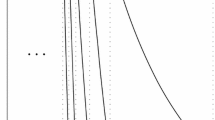Abstract
The portion of energy of a finite-duration signal hitting the given frequency interval was shown to be suitable as a basis for construction of the optimal methods of their analysis and synthesis. The relations obtained define directly these portions of energy in the signal space and enable one to formulate the variational conditions for their optimal processing. The problems of optimal detection (filtration) of the additive signal components and synthesis of signals featuring the maximal/minimal concentration of energy within the given frequency ranges were formulated and solved.
Similar content being viewed by others
References
Franks, L.E., Signal Theory, Englewood Cliffs: Prentice Hall, 1969. Translated under the title Teoriya signalov, Moscow: Sovetskoe Radio, 1974.
Khurgin, Ya.I. and Yakovlev, V.P., Finitnye funktsii v fizike i tekhnike (Finite Functions in Physics and Engineering), Moscow: Nauka, 1971.
Dvorkovich, V.P. and Dvorkovich, A.V., Tsifrovye videoinformatsionnye sistemy (teoriya i praktika) (Digital Video Information Systems (Theory and Practice)), Moscow: Tekhnosfera, 2012.
Vorob’ev, V.I. and Gribunin, V.G., Teoriya i praktika veivlet-preobrazovaniya (Theory and Practice of the Wavelet Transformation), St. Petersburg: Piter, 2006.
Sergienko, A.B., Tsifrovaya obrabotka signalov (Digital Signal Processing), St. Petersburg: BKHV-Peterburg, 2011.
Mallat, S., A Wavelet Tour of Signal Processing, New York: Academic, 1999. Translated under the title Veivlety v obrabotke signalov, Moscow: Mir, 2008.
Smolentsev, N.K., Osnovy teorii veivletov. Veivlety v Matlab (Fundamentals of the Wavelet Theory. Wavelets in Matlab), Moscow: AMK, 2008.
Smirnov, V.I., Kurs vysshei matematiki (Course in Higher Mathematics), Moscow: Nauka, 1974, vol. 4, part 2.
Rabiner, L. and Gold, B., Theory and Application of Digital Signal Processing, Englewood Cliffs: Prentice Hall, 1975. Translated under the title Teoriya i primenenie tsifrovoi obrabotki signalov, Moscow: Mir, 1978.
Gantmakher, F.R., Teoriya matrits (Theory of Matrices), Moscow: Nauka, 1967. Translated into English under the title Theory of Matrices, New York: Chelsea, 1959.
Author information
Authors and Affiliations
Corresponding author
Additional information
Original Russian Text © E.G. Zhilyakov, 2015, published in Avtomatika i Telemekhanika, 2015, No. 4, pp. 51–66.
Rights and permissions
About this article
Cite this article
Zhilyakov, E.G. Optimal sub-band methods for analysis and synthesis of finite-duration signals. Autom Remote Control 76, 589–602 (2015). https://doi.org/10.1134/S0005117915040049
Received:
Published:
Issue Date:
DOI: https://doi.org/10.1134/S0005117915040049




